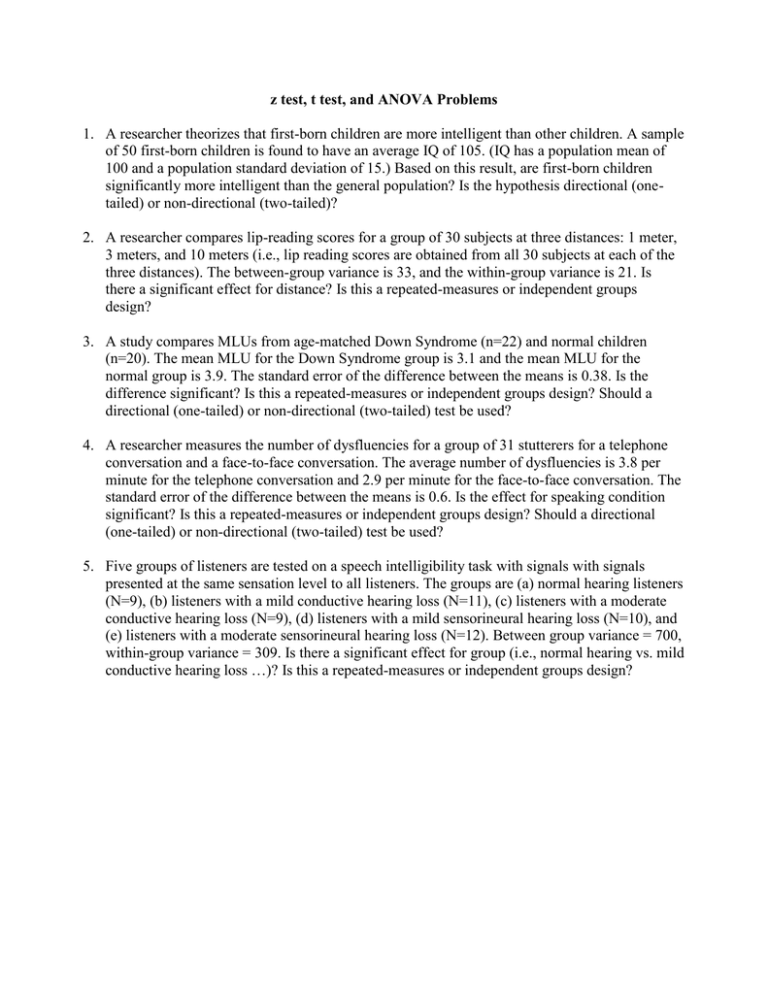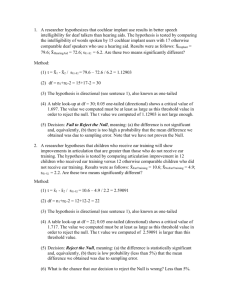z test, t test, and ANOVA Problems
advertisement

z test, t test, and ANOVA Problems 1. A researcher theorizes that first-born children are more intelligent than other children. A sample of 50 first-born children is found to have an average IQ of 105. (IQ has a population mean of 100 and a population standard deviation of 15.) Based on this result, are first-born children significantly more intelligent than the general population? Is the hypothesis directional (onetailed) or non-directional (two-tailed)? 2. A researcher compares lip-reading scores for a group of 30 subjects at three distances: 1 meter, 3 meters, and 10 meters (i.e., lip reading scores are obtained from all 30 subjects at each of the three distances). The between-group variance is 33, and the within-group variance is 21. Is there a significant effect for distance? Is this a repeated-measures or independent groups design? 3. A study compares MLUs from age-matched Down Syndrome (n=22) and normal children (n=20). The mean MLU for the Down Syndrome group is 3.1 and the mean MLU for the normal group is 3.9. The standard error of the difference between the means is 0.38. Is the difference significant? Is this a repeated-measures or independent groups design? Should a directional (one-tailed) or non-directional (two-tailed) test be used? 4. A researcher measures the number of dysfluencies for a group of 31 stutterers for a telephone conversation and a face-to-face conversation. The average number of dysfluencies is 3.8 per minute for the telephone conversation and 2.9 per minute for the face-to-face conversation. The standard error of the difference between the means is 0.6. Is the effect for speaking condition significant? Is this a repeated-measures or independent groups design? Should a directional (one-tailed) or non-directional (two-tailed) test be used? 5. Five groups of listeners are tested on a speech intelligibility task with signals with signals presented at the same sensation level to all listeners. The groups are (a) normal hearing listeners (N=9), (b) listeners with a mild conductive hearing loss (N=11), (c) listeners with a moderate conductive hearing loss (N=9), (d) listeners with a mild sensorineural hearing loss (N=10), and (e) listeners with a moderate sensorineural hearing loss (N=12). Between group variance = 700, within-group variance = 309. Is there a significant effect for group (i.e., normal hearing vs. mild conductive hearing loss …)? Is this a repeated-measures or independent groups design? Answers 1. IQ has a population mean of 100 and a population std dev of 15 standard error of the mean = 15 / sqrt(50) = 15 / 7.07 = 2.12 z = (105 - 100) / 2.12 = 5 / 2.12 = 2.35 From the z table, the probability associated with z = 2.35 = 0.0096. Therefore, the Null Hypothesis is not very likely. Using the conventional 0.05 threshold, the Null is rejected. The best case could be made for using a directional test since many studies have shown a consistent advantage for first-born and only children. In the absence of this knowledge, a non-directional test would be used. 2. F = 33 / 21 = 1.57 df = k-1, n-k = 3-1,30-3 = 2, 27 The critical value in the ANOVA table for 2,27 = 3.35 using the 0.05 level. Our calculated value is less than this. The difference is therefore not significant (we fail to reject the Null). This is a repeated measures design: the same subjects are being tested under 3 different conditions. 3. t = (3.9 - 3.1) / 0.38 = 2.11 df = 22 + 20 - 2 = 40 The critical value in the t test table for df = 40 is 1.684 at the 0.05 level using a one-tailed test. Our calculated value is greater than this. The difference is therefore significant (we reject the Null). This is an independent-groups design. The best case can be made for a directional test since the likelihood is that any effect that is found would tend to favor the normally developing children. 4. t = (3.8 - 2.9) / 0.6 = 1.50 df = 31 - 1 = 30 The critical value in the t test table for df = 30 is 1.697 at the 0.05 level using a one-tailed test. Our calculated value is less than this. The difference is therefore not significant (we fail to reject the Null). This is a repeated-measures design: Measurements are being made from the same subjects under two different conditions. The best case can be made for a directional test since common clinical experience suggests greater difficulty on the telephone. 5. F = 700/ 309 = 2.27 df = k-1, n-k = 5-1, 51-5 = 4, 46 The critical value in the ANOVA table for 4,46 = 2.57 using the 0.05 level. Our calculated value is less than this. The difference is therefore not significant (we fail to reject the Null). This is an independent-groups design: the subjects in the five groups are different people.




